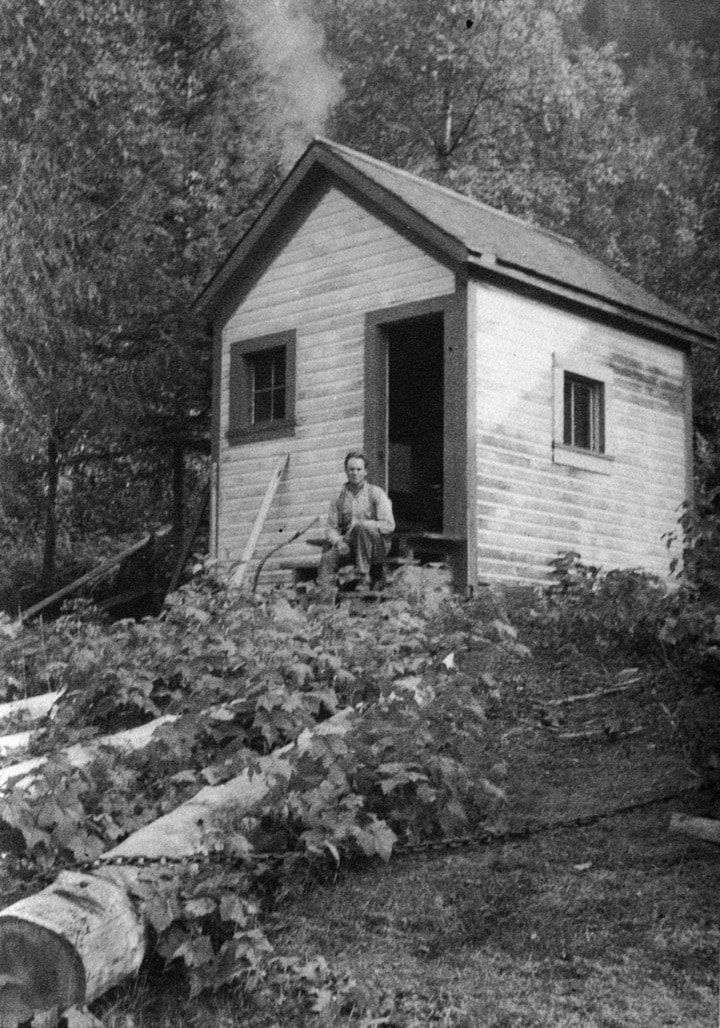The Lardeau Valley Museum building, which began its life in 1918 as the Gerrard fish hatchery staff residence, was recently reunited with its original outbuilding.
“We were taken by delightful surprise,” says Peter Jonker, current president of the Lardeau Valley Historical Society. “Delightful because this development fits perfectly within our ongoing agenda to bring together and preserve keystone representations of our valley’s rich past in a place where their stories can be educationally shared with visitors.”
The story of the Carson Cabin, as the outbuilding is now dubbed, came to the historical society’s attention this past spring. Art Carson — a grandson of Frank Carson who homesteaded a large tract of land in Meadow Creek — offered it to the society in exchange for a year’s membership and on condition that the society move it from the nearby hamlet of Lardeau where it was then located.
Carson, keenly interested in the cabin’s history, described its wanderings over the years.
“When the trout hatchery [at Gerrard] closed down in 1949,” said Carson, “Dad [Ralph Carson] bought a small frame building from them and used it as a base for trapping out of Gerrard. It sat at the northwest side of the hatchery yard adjacent to the edge of the forest … to the left of, and about 90 feet beyond, the main residence building that became the museum. Eventually Dad moved it to Meadow Creek and a few years later he moved it again to some land he had in Lardeau.”
This past month, after resting for 60 years on the beach overlooking the north end of Kootenay Lake, the cabin was loaded onto a trailer and reunited with the museum building.
When asked what the cabin was used for in Gerrard, Carson said, “The cabin had, and probably still has, a metal plate in the wall where the exhaust pipe of an engine seems to have exited the building. This would not have been a water pump since everything was gravity feed. The cabin might have originally been a generator shed for lighting at the hatchery buildings. The Gerrard townsite on the opposite side of the river originally had hydroelectric power from Mobbs Creek but this may have been abandoned and/or removed after the mill burned down.”
The historical society and membership volunteers have worked diligently in recent years to make the museum and our collections ever more attractive to a growing number of summer visitors.
“This past year,” said Jonker, “has seen a thorough repainting of the museum exterior and its interior upstairs rooms, some very significant additions to our collection, improvements to our road-sign, and now the addition of its original outbuilding.”
He applauds the many local volunteers and businesses who contributed to these projects: Boards by George, Hamill Creek Timber Homes, Colin Jacobs Logging, Kaslo Building Supplies Ltd, Steve Bueler, Jillian Madill, Sandra Rempel, Troy Hearne, Holly Hearne, Tyler Hearne, Pat Turner, Kevin Alexander, Jonathan Tremblay, Sandra Martens, Don Edwards, Kelly Abey, Jim Mainland, and Len Trenholm.
The museum’s collection has grown rapidly since 1997, when the historical society purchased the main building from BC Fisheries and moved it to Meadow Creek. Other buildings at the museum site include the Billy Clark cabin, moved from Howser prior to flooding the reservoir behind Duncan Dam, and the Bosworth railway shed/post office that stood alongside what is now Highway 31 adjacent to the tulip farm between Howser and Gold Hill.
